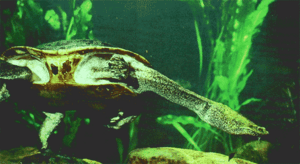Sandstone snake-necked turtle facts for kids
Quick facts for kids Sandstone snake-necked turtle |
|
|---|---|
 |
|
| Swimming | |
| Conservation status | |
| Scientific classification | |
| Genus: |
Chelodina
|
| Species: |
burrungandjii
|
| Synonyms | |
|
|
The sandstone snake-necked turtle (scientific name: Chelodina (Chelydera) burrungandjii) is a cool reptile! It's a medium-sized turtle, growing up to about 31.6 centimeters long. You can find this special turtle in the rocky areas and waterfalls of Arnhem Land in the Northern Territory of Australia. It loves the pools at the bottom of cliffs.
For a long time, scientists knew about this turtle. However, it was hard to study because its home is very remote. Trying to breed these turtles in zoos was also tough. But in 2021, a scientist named Matthew Benedict led a successful breeding project.
This turtle lives near another type of snake-necked turtle, the Northern snake-necked turtle (Chelodina rugosa). They are very close relatives. Most of the time, they live in different areas. But sometimes, they meet in places like the pools at the bottom of cliffs. When they meet, they can sometimes have baby turtles together that are a mix of both species.
Contents
About the Sandstone Snake-Necked Turtle
The sandstone snake-necked turtle is known for its long neck, which looks a bit like a snake. This helps it catch fish! It has a flattened head and a large mouth. Its back feet and legs are quite big, which helps it swim well.
Turtle Family Tree
When scientists first described the sandstone snake-necked turtle, they thought some turtles from the Kimberley Region were the same species. But later, they found out those were a different species called Chelodina walloyarrina.
The sandstone snake-necked turtle's closest relatives are Chelodina walloyarrina and the Northern snake-necked turtle (Chelodina rugosa). These turtles, along with Chelodina expansa, Chelodina kuchlingi, and Chelodina parkeri, belong to a special group called Chelydera.
How Chelydera Turtles Hunt
Turtles in the Chelydera group are special hunters. They are called "strike and gape piscivores." This means they quickly open their large mouths and strike to catch fish. They have smaller bottom shells (called plastrons) compared to other turtles.
Other Turtle Groups
There are other groups of Chelodina turtles too. One group, simply called Chelodina, has more complete bottom shells and shorter necks. They don't hunt in the same "strike and gape" way.
Another group, Macrodiremys, has only one species: the Southwestern snake-necked turtle (Chelodina colliei). This turtle lives in southwest Australia and is quite similar to some turtles found in South America called Hydromedusa.
- Chelodina burrungandjii at the TIGR Reptile Database
See also
 In Spanish: Tortuga de cuello de serpiente de Arnhem para niños
In Spanish: Tortuga de cuello de serpiente de Arnhem para niños


